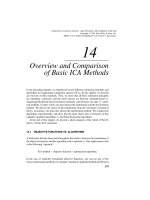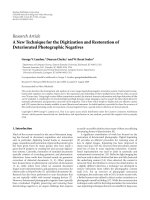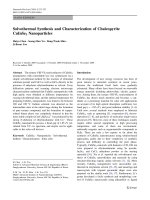UNSTEADY AERODYNAMICS, AEROACOUSTICS AND AEROELASTICITY OF TURBOMACHINES Episode 2 pptx
Bạn đang xem bản rút gọn của tài liệu. Xem và tải ngay bản đầy đủ của tài liệu tại đây (3.62 MB, 50 trang )
Flutter Design of Low Pressure Turbine Blades with Cyclic Symmetric Modes 43
in the Panovsky-Kielb method, baseline unsteady aerodynamic analyses must
be performed for the 3 fundamental motions, two translations and a rotation.
Unlike the current method work matrices must be saved for a range of reduced
frequencies and interblade phase angles. These work matrices are used to gen-
erate the total work for the complex mode shape. Since it only requires knowl-
edge of the reduced frequency and mode shape (complex), this new method
is still very quick and easy to use. This paper describes the complete theory
for extension of the Panovsky-Kielb method, gives example results, discusses
the importance of the interaction effects of the cosine and sine modes, and
discusses the contribution to work associated with the steady pressure.
2. Work for General Complex Mode Shapes
Work per cycle can be calculated by integrating the dot product of the local
velocity vector with the local force vector over one cycle of vibration and the
entire airfoil surface.
Figure 2. Coordinate Systems
W
cyc
=
A
T
0
−
˙
Φ ·
NP
dtdA
where
˙
Φ=velocity
N = normal vector
P = surface pressure
p
real
= p
cr
+ p
si
p
imag
= p
ci
− p
sr
W
up
= π
A
(a
c
(p
ci
− p
sr
)+a
s
(p
cr
+ p
si
)) · ndA
W
up
= π
A
(a
c
p
ci
) · ndA + π
A
(a
s
p
si
) · ndA − π
A
(a
c
p
sr
) · ndA + π
A
(a
s
p
cr
) · ndA
W
up
(forward traveling wave) = W
cc
+ W
ss
− W
cs
+ W
sc
As can be seen W
cc
and W
ss
(diagonal terms) represent the work due to the
unsteady pressure acting on the mode shape producing that unsteady pressure.
The W
cs
and W
sc
terms (off-diagonal) represent the interaction terms. That is,
the work caused by the unsteady pressure due to the sine mode acting upon the
mode shape due to the cosine mode, and vice versa.
5. Rigid Body Mode Shapes
As in Panovsky and Kielb (1998) the three dimensional mode shapes are
reduced to a two dimensional rigid body mode shape consisting of two trans-
lations and one rotation about the leading edge (See Figure 2).
{a
lc
} =
h
ξlc
h
ηlc
α
lc
and {a
ls
} =
h
ξls
h
ηls
α
ls
The l subscript defines the nodal diameter, and determines the interblade phase
angle, of the mode.
Figure 3. Aerodynamic Damping for Blade BT Mode 1
46
Now consider the term, W
cc
.
W
cc
= π
A
(a
c
p
ci
) ·ndA
a
c
= h
ξc
φ
ξ
+ h
ηc
φ
η
+ α
c
φ
α
φ
ξ
,
φ
η
are unit vectors in the ξ and η directions, respectively
φ
α
is a vector in the η direction with an amplitude equal
to the distance from the leading edge
p
ci
= h
ξc
C
ξi
+ h
ηc
C
ηi
+ α
c
C
αi
The C
i
terms are the imaginary parts of the linearized unsteady aerodynamic
coefficients. As in Panovsky and Kielb (1998) the work term can then be writ-
ten as
W
cc
=
h
ξc
h
ηc
α
c
w
ξξ
w
ξη
w
ξα
w
ηξ
w
ηη
w
ηα
w
αξ
w
αη
w
αα
h
ξc
h
ηc
α
c
where
w
ab
= π
A
φ
a
C
bi
·n
dA
By similarity
W
ss
=
h
ξs
h
ηs
α
s
w
ξξ
w
ξη
w
ξα
w
ηξ
w
ηη
w
ηα
w
αξ
w
αη
w
αα
h
ξs
h
ηs
α
s
The interaction terms can also be shown to be of the form
W
cs
=
h
ξc
h
ηc
α
c
˜w
ξξ
˜w
ξη
˜w
ξα
˜w
ηξ
˜w
ηη
˜w
ηα
˜w
αξ
˜w
αη
˜w
αα
h
ξs
h
ηs
α
s
˜w
ab
= π
A
φ
a
C
br
·n
dA
The C
r
terms are the real parts of the unsteady aerodynamic coefficients. To
get the W
sc
terms simply interchange the c and s subscripts. In the new method
presented herein, these three-by-three work matrices must be generated for a
baseline airfoil for a range of interblade phase angles and reduced frequencies.
These matrices can then used for a wide range of LPT blade designs.
6. Steady Pressure Term
Now consider the work due to the steady pressure for the same rigid body
mode shapes. It can be shown that for the forward traveling wave.
Flutter Design of Low Pressure Turbine Blades with Cyclic Symmetric Modes 47
W
Ps
= −π
A
[P
s
(a
c
· n
s
− a
s
· n
c
)] dA =
−π
(α
s
h
c,ξ
− α
c
h
s,ξ
)
A
P
s
cos (θ
N
(A)) dA +(α
c
h
s,η
− α
s
h
c,η
)
A
P
s
sin (θ
N
(A)) dA
The term θ
N
is the local angle between the surface normal and the chord
line. Therefore the first integration term is the steady lift and the second is the
steady drag. In general the work associated with the steady pressure is nonzero
for airfoils producing lift and drag, and having both translational and rotational
motion.
7. Backward Traveling Waves
For backward traveling waves the interblade phase angle changes sign and
the mode shape is
φ = a
c
+ ia
s
The work associated with the unsteady pressure then becomes
W
up
(backward traveling waves)=W
cc
+ W
ss
+ W
cs
− W
sc
Thus, the sign of the interaction terms is negative of that for the forward trav-
eling waves. Note that all of these individual work terms are different from
those of the forward traveling waves because the interblade phase angle is also
switched in sign. The work associated with the unsteady pressure, W
Ps
,isthe
negative of that shown above for the forward traveling wave.
8. Example Problems
A finite element cyclic symmetry analysis was performed on a LPT turbine
rotor (Blade BT). For the first 20 nodal diameter mode the reduced frequency
is 0.23 and the mode shapes for the forward traveling wave are
{a
20c
} =
−0.260
−0.036
−0.638
and {a
20s
} =
−0.072
−0.059
0.149
Since 92.1% of the kinetic energy is in cosine mode, this mode is expected to
dominate. The cosine mode has a pitching axis at (ξ=-0.056, η=0.407). For this
location the traditional P-K method plot gives a critical reduced frequency of
approximately 0.1. The sine mode has a pitching axis at (ξ=0.396, η=-0.482)
for which the critical reduced frequency is approximately 0.5. Therefore, the
traditional method judges the cosine mode to be stable and the sine mode to be
unstable.
Figure 4. Aerodynamic Damping for Blade BT Mode 1
Figure 5. Aerodynamic Damping for Blade BT Mode 2
50
Figure 6. Blade AT Mode 1 Damping Contributions
Figure 7. Blade AT Mode 2 Damping Contributions
Flutter Design of Low Pressure Turbine Blades with Cyclic Symmetric Modes 51
instability and the 3D CFD method predicting stability. This type of error is
preferred for a preliminary design screening tool.
The results for Blade BT were further examined to determine the contri-
butions to total damping from the individual work terms. Four representative
nodal diameters were selected for study. The 2 nodal diameter mode is nearly a
pure sine mode (99.2% of total energy). The 5 nodal diameter mode is predom-
inately a sine mode (90.8% of total energy). The 20 nodal diameter mode is
predominately a cosine mode (92.1% of total energy). The 50 nodal diameter
mode is nearly a pure cosine mode (99.9% of total energy). Figure 5 shows the
damping contributions (critical damping ratio) from the W
cc
,W
ss
,W
cs
,W
sc,
and W
Ps
work terms. That is, the individual work terms are divided by 4π
times the total energy. A positive number represents a stabilizing contribution.
The 2 nodal diameter results show that contribution of the interaction terms
can be significant for nearly pure real modes. That is, the W
sc
contribution is
approximately half of the contribution of the W
ss
. The 5 nodal diameter for-
ward traveling wave results show that the interaction term can be the dominant
contributor. The effect of the steady pressure terms is anti-symmetric about
zero nodal diameters. At 5 nodal diameters the contribution of the steady pres-
sure term is larger than that of W
cc
and W
ss
. In this case the contribution of the
steady pressure term decreases as the number of nodal diameters is increased.
Figure 8. Damping Contributions
52
9. Summary & Conclusions
This paper presents an extension to the traditional Panovsky-Kielb for flut-
ter analysis of LPT blades that considers the cyclic symmetry mode shapes.
As demonstrated in the example problems this new cyclic symmetry method
produces aerodynamic damping results that are in reasonable agreement with
those of complete three-dimensional viscous CFD method. It does not require
any additional input information or CFD analysis. The work due to the interac-
tion effects of the cosine and sine modes was generally found to be significant,
even for some nearly pure real modes. In addition, the work associated with
the steady pressure was also found to be significant.
Acknowledgement
The authors wish to acknowledge GE Aircraft Engines for financial support
and for the permission to publish this work. The authors also express gratitude
to Francesco Poli (University of Florence) and Claudia Schipani (Fiat Avio)
for their cooperation on the test cases.
References
[1] Arnone, A, Poli, F., and Shipani, C., 2003, A Method to Assess Flutter Stability of Complex
Modes, Accepted for Presentation at the 10
th
ISUAAAT, Duke University, September 2003
[2] Chernycheva, O. V., Fransson, T. H., Kielb, R. E., and Barter, J., 2001, ”Comparative anal-
ysis of blade mode shape influence on flutter of two-dimensional turbine blades”, ISABE-
2001-1243, XV ISOABE conference, September 2-7, Bangalore, India
[3] Kielb, R. E., and Barter, J., Chernycheva, O. V., and Fransson , T. H., 2003, ”Flutter of Low
Pressure Turbine Blades with Cyclic Symmetric Modes – A Preliminary Design Method”,
presented at ASME Turbo Expo 2003, June 2003, Atlanta, Georgia, accepted for publica-
tionintheASME Journal of Turbomachinery.
[4] Panovsky J., and Kielb R. E., 1998, “A Design Method to Prevent Low Pressure Turbine
Blade Flutter”, 98-GT-575, ASME Gas Turbine Conference and Exhibition, Stockholm,
Sweden
EXPERIMENTAL AND NUMERICAL
INVESTIGATION OF 2D PALISADE
FLUTTER FOR THE HARMONIC
OSCILLATIONS
Vladymir Tsimbalyuk, Anatoly Zinkovskii
Institute for Problems of Strength, Ukrainian National Academy of Sciences
Ukrainian National Academy of Sciences, 2 Timiriazevskaia str., 01014 Kiev, Ukraine
Vitaly Gnesin
Department of Aerohydromechanics, Institute for Problems in Machinery
Ukrainian National Academy of Sciences, 2/10 Pozharsky st., Kharkov 310046, Ukraine
Romuald Rzadkowski, Jacek Sokolowski
Institute of Fluid-Flow Machinery, Polish Academy of Sciences
80-952 Gdansk, ul. Fiszera 14, Polish Naval Academy
Abstract The verification of the computational models for unsteady flows through the os-
cillating blade row becomes more difficult, because the experimental data for
three-dimensional flows are currently hardly available in the published litera-
ture. Therefore comparisons between numerical methods and experimental ones
for simple cascade geometry at inviscid flow conditions must play an essential
role in validation of the three -dimensional unsteady solution methods. In this
study the numerical calculations were performed to compare the theoretical re-
sults with experiments for the harmonic motion. The calculations were carried
out for the torsional and bending oscillations of the compressor cascade. The
comparison of the calculated and experimental results for different conditions of
the cascade oscillations has shown the good quantitative and qualitative agree-
ment.
Keywords: flutter, inviscid, blades
53
Unsteady Aerodynamics, Aeroacoustics and Aeroelasticity of Turbomachines, 53–63.
© 2006 Springer. Printed in the Netherlands.
(eds.),
et al.
K. C. Hall
54
1. Introduction
Cases of flutter-type instability are sometime encountered in the course of
developing new gas turbine engines. Costly testing is necessary to eliminate
this problem. One of the main problems in predicting flutter at the engine de-
sign stage is determining the transient aerodynamic loads that develop during
the vibrations of blades. This problem is particularly important in the case of
separated flow, when theoretical methods of determining the transient aerody-
namic loads are not yet sufficiently reliable. Thus, in this study, we use an
experimental method of determinate the transient aerodynamic loads on the
vibrating blades of turbine engine.
It is quite difficult to measure the aerodynamic loads along the blades during
rotation of the blading ring. Thus, with allowance for the three-dimensional
nature of the air flow about the ring, the cylindrical sections of the ring are often
modeled as vane cascades. When such a cascade is placed in a wind tunnel, the
flow parameters, geometric characteristics, and vibration parameters should be
constant along the vanes.
The aeroelastic results of bending vibrations of 2D linear cascade in sub-
sonic flow were published by Kaminier and Stel’makh 1996 and torsional
Kaminier et al. 1988. The experimental results of aero-damping and dynamic
stability of compressor cascades under bending-torsional vibrations were pre-
sented in Len et al. 1986.
Useful benchmark data, which became a de facto standard for unsteady cas-
cade flows, can be found in Bölcs and Fransson 1986 for the EPFL series of
Standard configurations.
Aerodynamic loads are measured indirectly either through the aerodynamic
damping of bladed vibrations by Kaminier and Nastenko 1973 or the distribu-
tion of transient pressures on the blade surfaces Tanaka et al. 1984. They are
measured directly with an extensometric dynamometer Kimura and Nomiyama
1988 or on the basis of the forces developed by vibrators Kaminier at el. 1988.
In the Institute for Problem of Strength of NAS of Ukraine the proper 2D
experimental bench was developed to measure simultaneously unsteady aero-
dynamic force and moment with arbitrary combinations of motions y and a of
airfoil cascades in the subsonic flow. Description of such test bench is given in
paper Tsimbalyuk et al. 2002.
2. Test Stand
To realize flow about the vane cascade with prescribed velocities and angles
of attack, the cascade was placed in a wind tunnel (Figures 1, 2 )inwhich
Mach numbers up to 0.7 could be attained. The four central vanes in the cas-
cade were secured to individual vibration units and could undergo prescribed
vibrations with two degrees of freedom. Since there was some mechanical
Experimental and Numerical Investigation of 2D Palisade Flutter 55
coupling even with vibration-proofing elements between the units, it was nec-
essary to keep the vibrations in all of the units steady (whether there was a
flow or not) in order to prevent this coupling from affecting the measurement
results. Proceeding on the basis of this requirement, we employed an eight-
channel feedback system to automatically control the vibrations of the vanes
(vibration units). The system also controls the voltages and, thus, the forces
on the vibrator coils so as to reduce the difference between the signal of the
master oscillator and the vane vibration signal obtained in each channel (the
equipment used was described in more detail in Tsymaluk 1996).
Figure 1. Test stand
The considered cascade consists of 9 airfoils. The central three were fas-
tened cantilever on the individual vibro-unit (see Figure 3), they could ac-
complish assigned displacements, aerodynamic loads were measured on them.
Such airfoils are called active. An elastic suspension was designed for vanes
that has two elastic elements of different widths. The auxiliary (narrow) elas-
56
Figure 2. Linear Test Facility, 1 - nuzzle wall; 2 - Pito tube; 3 - blade; 4 - airfoil; 5,8 - outlet
rotary screens; 6 - rotary disk; 7 - openings for static pressure release
tic element does not impede the twisting of the main (wide) element about its
own longitudinal axis, and during flexural vibrations the two elements form an
elastic parallelogram. This setup ensures constant vibration parameters along
the vane. The unit just described also makes it possible to change the natu-
ral frequencies of the suspension by using replaceable main elements differing
only in thickness.
Figure 3. Structure of the airfoil flexible suspension 1 - airfoil; 2 - voice coil of the vibrator;
3 - elastic elements; 4 - strain gages
Experimental and Numerical Investigation of 2D Palisade Flutter 57
There were used three active airfoils to asset aerodynamic loads on initial
airfoil (n=0), which were induced by vibration of airfoils -2, using designed
experimental workbench. This could be accounted for periodicity of influence
of airfoil n = -1 on n = 1 one to be the same as for n = -2 on n = 0, influence of
n = 1 airfoil on n = -1 - the same as for n = 2 on n = 0 airfoil.
In accordance with developed method, the required vibrations were induced
for every active airfoil. The first harmonic of the unsteady aerodynamic force
and moment was measured on them. It should be noted, that determined un-
steady aerodynamic forces and moments, and thus aerodynamic influence co-
efficients (AIC) were related to the center of airfoil chord, about which its
angular displacement occurred.
The geometrical characteristics of the compressor cascade and oscillation
regimes are presented by Tsimbalyuk et al. 2002. The blade length L=0.069
m, the chord length b= 0.05 m, the circular camber 10
o
, the thickness-to chord
ration 0.07, the stager angle 60 deg., pitch-to -chord ration 0.78, the inlet Mach
number 0.12 -0.35, the vibration amplitude ho =0.0007 m, α
o
=0.0084 rad.
The cross-section of the blade is presented in Figure 4.
Figure 4. Airfoil coordinates, solid line-suction side, dashed line -pressire side
In order to calculate the AIC the vibrations of airfoils were induced by turns.
The vibration amplitude of the blade was almost invariable along its length and
equal to ω = 85.85 Hz, which is equal to the natural frequency of the system.
3. Aeroelastic Model
Let assume that the blades are non-twisted with a constant cross-sectional
area along the blade length. The centre of shear and gravity of the blade cross-
sections coincide. Let us consider the motion of nth blade as plane motion of
the solid body with two degrees of freedom. The transverse displacements of
the nth blade in x, y directions (h
x
n
,h
y
n
) are described as:
h
x
n
(t)=h
x
0
sin[ω
n
t +(n − 1)δ],
0
2
4
00 05 10 15 20 25 30 35 40 45 50
x
y
Figure 5. The aerodynamic work coefficient in dependence of IBPA for the bending vibration
(i = 0
ˇ
r, Strouhal Number - Sh = 0.2 - 0.616)
and experimental results is good. For torsional oscillations in the range of 0
deg. < IBPA < 180 deg. the work coefficients have positive value that cor-
responds to the transfer of energy from the flow to the oscillating blade. The
maximal excitation occurs near δ = +90 deg.
Figure 6. The aerodynamic work coefficient in dependence of IBPA for torsion vibration (I =
0
ˇ
r, Strouhal Number - Sh = 0.616)
The aeroelastic characteristics at the bending vibration for the attack flow
angle of 16 deg is presented in Figure 7. The agreement between the exper-
Experimental and Numerical Investigation of 2D Palisade Flutter 61
Figure 7. Aerodynamic work coefficient in dependence of IBPA for the bending vibration (i
=16
ˇ
r, Strouhal Number - Sh = 0.616)
imental and numerical results near the IBPA of 0 deg is seen although some
discrepancy for IBPA of 180 deg is found.
In Figures 8, 9 and 10 the calculated and measured amplitude of unsteady
forces at the bending oscillations, for different incidence angles were shown.
The calculation of the unsteady amplitude by using the aerodynamic influence
coefficients were done taking into account only four neighbouring blades ( -1
≤ n ≤ 1) and two neighbouring blades ( -2 ≤ n ≤ 2). From results presented
in these Figures it is seen that for considered flow regime taking into account
only two neighbouring blades give the satisfactory agreement with numerical
calculations.
5. Conclusions
1. A partially - integrated method based on the solution of the coupled
aerodynamic-structure problem is used for calculation of unsteady 3D flow
through an oscillating blade row to determine the critical conditions of flutter
initiation.
2. The numerical investigation has been performed to calculate aeroelastic
response of the compressor cascade at the different flow regimes and laws of
oscillations.
3. The comparison of calculated and experimental results for bending and
torsional oscillations has shown a satisfactory quantitative and qualitative agree-
ment.
62
Figure 8. Amplitude of unsteady aerodynamic force at the bending oscillations
Figure 9. Amplitude of unsteady aerodynamic force at the bending oscillations i = 0, Sh =
0.616
References
Bölcs A., Fransson T.H. (1986) Aeroelasticity in Turbomachines Comparison of Theoretical and
Experimental Cascade Results, Communication du Laboratoire de Thermique Appliquée et
Turbomachines, Nr.13. Lusanne, Epfel.
Bölcs A., and Fransson T.H. (1986). Aeroelasticity in Turbomachines Comparison of Theoret-
ical and Experimental Cascade Results, Communication du Laboratoire de Thermique Ap-
pliquée et Turbomachines, Nr.13, Appendix A5 All Experimental and Theoretical Results
for the 9 Standard Configurations, Lusanne, Epfel.
Experimental and Numerical Investigation of 2D Palisade Flutter 63
Figure 10. Amplitude of unsteady aerodynamic force at the bending oscillations i = 16, Sh =
0.616
Stel’makh A.L., Kaminer A.A. (1981). Effect of the geometrical parameters of a compressor
cascade on the limit of bending self-oscillations of blades caused by cascade flutter, Strength
of Materials, 15, 1, 104-109.
Kaminer A.A., Stel’makh A.L. (1996). Effect of the aerodynamic connectedly between blades
of the aerodynamic damping of their vibrations, and origin of cascade flutter, Strength of
Materials, 14, 12, 1667-1672.
Kaminer A.A., Chervonenko A.G., and Tsymbalyuk V.A. (1988). Method for Studying Un-
steady Aerodynamic Characteristics of Airfoil Cascades vibrating in a Three-Dimensional
Flow. Preprint. Institute for Problems of Strength, Ac. Sci. of the Ukr.SSR, Kiev 1988 (in
Russian).
Len A.D.,Kaminer A.A., Stel’makh A.L., Balalaev V.A. (1986). Loss of dynamic stability of
torsional vibrations of blades due to cascade flutter, Strength of Materials, 18, 1, 76-80.
Gnesin V., and Rzadkowski R. (2000). The theoretical model of 3D flutter in subsonic, transonic
and supersonic inviscid flow, Transactions of the Institute of Fluid-Flow Machinery, No. 106,
45-68.
Gnesin V., Rzadkowski R. (2002). A Coupled Fluid-Structure Analysis for 3D Inviscid Flutter
of IV Standard Configuration, Journal of Sound and Vibration, 251(2), 315-327.
Gnesin V., Rzadkowski R. and Kolodyazhnaya, L., V. (2000). A coupled fluid-structure analysis
for 3D flutter in turbomachines, ASME paper 2000-GT-0380.
Rzadkowski R., Gnesin V. (2000). The numerical and experimental verification of the 3D invis-
cid code, Transactions of the Institute of Fluid-Flow Machinery, No. 106, 2000, 69-95.
Rzadkowski R. (1998). Dynamics of steam turbine blading. Part two: Bladed discs, Ossolineum,
WrocŠaw-Warszawa.
Tsimbalyuk V.A. (1996). Method of measuring transient aerodynamic forces and moments on
vibrating cascade , Strength of Materials, 28, 2, 150-157.
Tsimbalyuk V.A., Zinkovski A.P and Rzadkowski R. (2002). Experimental Investigation of Pal-
isade Flutter for the Harmonic Oscillations, Proc. of the XV Conference of Flow Mechanics,
Augustow, Poland
POSSIBILITY OF ACTIVE CASCADE
FLUTTER CONTROL WITH SMART STRUCTURE
IN TRANSONIC FLOW CONDITION
Junichi Kazawa
Toshinori Watanabe
Department of Aeronautics and Astronautics, University of Tokyo
7-3-1 Hongo Bunkyo-ku, Tokyo 113-8656, Japan
Phone : +81 3 5841-6624 Fax : +81 3 5841-6622
Abstract To study the possibility of active cascade flutter control by application of smart
structure, numerical analyses were performed under transonic flow conditions
with passage shock waves by a developed flow-structure coupled method. In
the flow condition of the present study, the unsteady aerodynamic force induced
by the shock oscillation was dominant for instability of blade vibration. The
direction of blade movement during oscillation was first adopted as the control
parameter, because it was known to be a quite influential factor for vibration in-
stability of blades in the transonic flows. The method could decrease the passage
shock movement near the blade surface and effectively suppress the blade vibra-
tion, though it was not effective when the blade stiffness was small. For more
effective control, the method in which the trailing edge of blade was actively
vibrated was sought to control the passage shock oscillation. The trailing edge
oscillation might be realized by, for instance, application of piezo-electric de-
vice. The method was revealed to change the unsteady aerodynamic force acted
on the blade from exciting to damping force if the phase of trailing edge oscil-
lation was properly selected. The suppressing effect of the control method came
from its effect on passage shock movement, which was confirmed by developed
flow-structure coupled method.
1.
Active control of surge and rotating stall has been successfully studied in the
last decade [1] including phenomenological description of the onset of insta-
bility and control mechanism. Concerning the cascade flutter problem, some
active control techniques have also been reported, in which acoustic waves are
introduced to suppress the flutter [2], or the acoustic impedance on casing wall
is actively controlled to reduce the exciting energy of the oscillating blade [3].
Introduction
65
Unsteady Aerodynamics, Aeroacoustics and Aeroelasticity of Turbomachines, 65–76.
© 2006 Springer. Printed in the Netherlands.
(eds.),
et al.
K. C. Hall
66
On the other hand, the study of "smart structure" has been advanced in the
research field of structures and materials. The smart materials can deform
themselves reacting to electric signals. Active control techniques, in which the
smart materials are applied to the flap of the aircraft wing or fuselage panel,
have been proposed so far [4] to prevent flutter instability of them. If the char-
acteristics of smart materials are properly utilized for the active control of cas-
cade flutter, an effective and reliable control method can be realized since such
materials directly change the structural characteristics of the vibrating materi-
als, or can give flexible deformation of the blades.
The authors have studied some methods of cascade flutter control by use
of the developed flow-structure coupled method. For example, flutter suppres-
sion was found to be possible by changing natural frequency of blade in the
subsonic flow condition [5]. The control can be realized by the application of
Shape Memory Alloy.
In the present study, two methods of the cascade flutter control were ana-
lyzed for suppression of vibration instability in transonic flow conditions with
passage shock waves. In the studied flow condition, it is well known that the
unsteady aerodynamic force induced by the movement of passage shock wave
is dominant for blade vibration instability. It is also known that the direction
of blade movement during oscillation is a quite influential factor for flutter
instability.
Based on the knowledge above, the possibility of flutter suppression by
changing the oscillation direction of blades was investigated first. The change
in the direction can be carried out with, for instance, some kind of shape mem-
ory alloy. The second method was to give forced oscillation on the trailing edge
section of blades. It was thought that the occurrence of cascade flutter could
be suppressed through the change in the oscillatory motion of shock waves im-
pinged to the blade surfaces. The forced vibration of the trailing edge section
can be realized with piezo-electric devices.
The results of these numerical studies are reported in the present paper.
2.
A numerical flow-structure coupled method has been developed in the course
of the present study [5]. Figure 1 shows the procedure of the method. The com-
puted unsteady aerodynamic force in the flow calculation is introduced into the
structural calculation in which the equation of motion of the blade is solved to
obtain the blade displacement. The computed blade displacement is used for
generation of the new grid coordinates in the next time step of flow calculation.
The flow calculation is based on the two-dimensional nonlinear Euler equa-
tion, that is solved through a second order upwind TVD scheme. LU-ADI
Numerical Argorithm
Figure 3. Structural Model
Figure 4. Cascade Model (Tip Section
of Quiet Fan B)
damping, D, was neglected in the present analysis to concentrate our focus on
the aerodynamic damping effect in the flow-structure coupled situation.
3.
The tip section of Quiet Fan B in NASA Quiet Engine Program [6], shown
shows the computed steady Mach contours in the case when inlet Mach number
is 1.25, and the static pressure ratio (po/pi, i;inlet, o;outlet) is 1.7. A passage
shock wave generated at the trailing edge of each blade can be clearly seen
in flow channels. Concerning vibration instability of this cascade model, the
oscillation of the passage shock wave is known to be the most influential factor.
An oblique shock is generated at the leading edge of each blade, and impinges
to the suction surface of the adjacent blade.
Figure 5. Mach contour
Figure 6. Unsteady Aerodynamic Work
in Fig.4, was adopted as the cascade model for the present analysis. Figure 5
An Analysis of Blade Vibration
Instability









